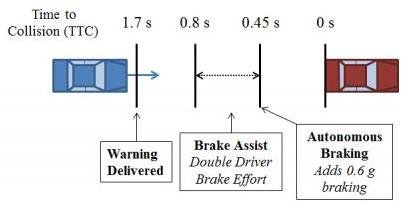The collision avoidance systems being studied would activate in three stages: warning, brake assistance, and autonomous braking. Credit: Virginia Tech
BLACKSBURG, Va., Oct. 3 (UPI) -- Warning systems and automatic braking technologies offered as options on some cars can help save lives, engineers at Virginia Tech say.
Clay Gabler, a professor of biomedical engineering, and Kristofer Kusano, a doctoral student in mechanical engineering, are conducting research on the potential benefit of collision avoidance systems available as options on some new cars, a Virginia Tech release reported Wednesday.
They are looking at three systems that can operate independently or in sequence to prevent or mitigate a rear-end collision by offering a warning and then braking assistance to a following car in a two-car collision.
One system begins with a warning 1.7 seconds before a potential crash and when the driver begins to apply the brakes there is brake assistance.
"The car says, 'Let me show you how to do it more effectively' and applies the necessary braking force," Gabler said.
Finally, 0.45 seconds before the collision, the car will add 0.6 G to the braking effort or if there is no braking will apply the brakes autonomously.
"These systems require radar and sophisticated computers. So there is a lot of interest in determining how efficient they could be to guide development," Kusano said.
The study said 7.7 percent of crashes would be prevented by use of all three systems -- warning, assisted braking and autonomous braking -- with a potential to reduce injuries 50 percent.
"That surprised me," Kusano said of the injury reductions. "That is on a level with seat belts."















